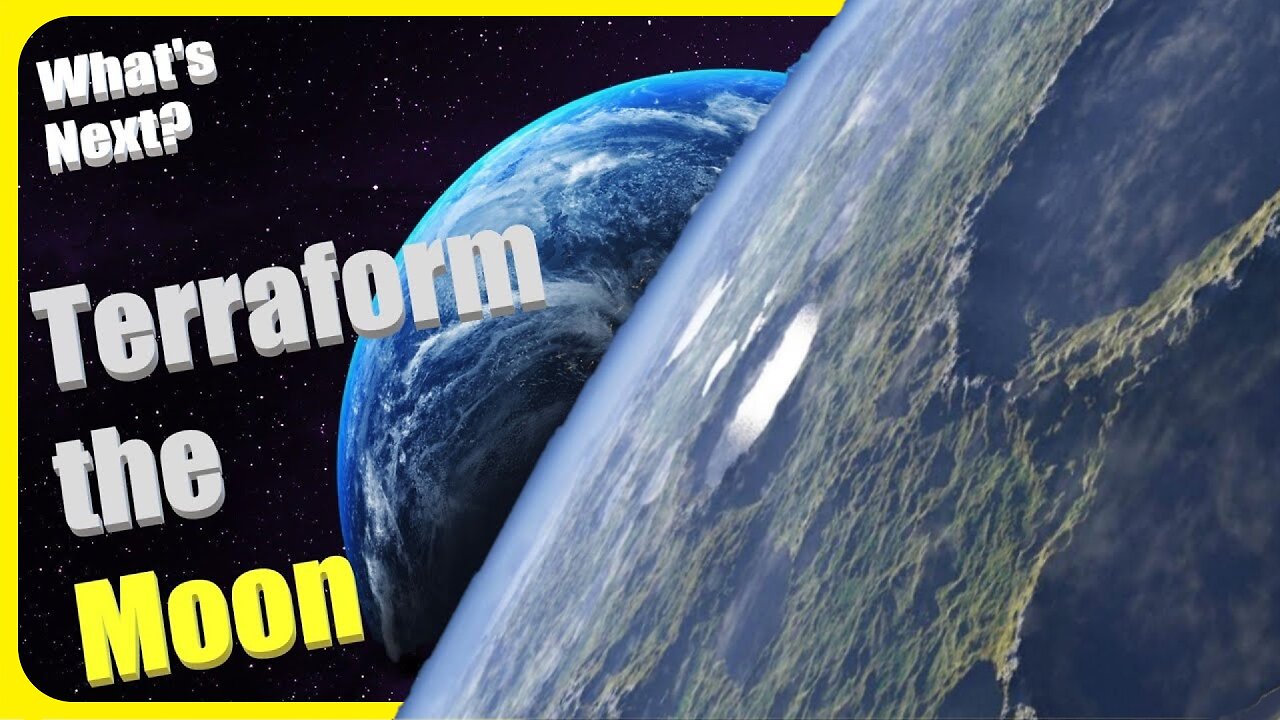Premium Only Content

Let's Turn the MOON Into Another EARTH
Patreon - https://www.patreon.com/user?u=37594401
Buy Me A Coffee? - https://www.buymeacoffee.com/whats.next
Donate With Cash App - https://cash.app/$YTpayments
Get Mentioned In Future Videos By Joining PATREON For As Little As $5 A Month
(and gain access to DOZENS of videos!)
Support Direct Improvements To The Channel With BUY ME A COFFEE
Or Make Direct Contributions With No Strings Attached With CASH APP
Welcome back to our ongoing series, “The Definitive Guide To Terraforming”! We continue with a look at the Moon, discussing how it could one day be made suitable for human habitation.
Ever since the beginning of the Space Age, scientists and futurists have explored the idea of transforming other worlds to meet human needs. Known as terraforming, this process calls for the use of environmental engineering techniques to alter a planet or moon’s temperature, atmosphere, topography or ecology (or all of the above) in order to make it more “Earth-like”. As Earth’s closest celestial body, the Moon has long been considered a potential site.
Terraforming: why the Moon is a better target than Mars
The first world that humans should inhabit beyond the Earth is the Moon, not Mars. Here's why terraforming our lunar neighbor is so appealing.
No matter how advanced our civilization here on Earth becomes, there’s a sobering fact we have no choice but to reckon with: Earth’s resources are finite. That not only includes the resources we typically think of, like minerals, clean water, and breathable air, but also something even more fundamental and restrictive: land area. No matter how thoroughly we develop, there’s only a finite amount of continental land area to inhabit on our planet.
Although the gravity on Earth's moon is too low to hold an atmosphere for geological spans of time, if given one, it would retain it for spans of time that are long compared to human lifespans.[34][35] Landis[35] and others[36][37] have thus proposed that it could be feasible to terraform the moon, although not all agree with that proposal.[38] Landis estimates that a 1 PSI atmosphere of pure oxygen on the moon would require on the order of two hundred trillion tons of oxygen, and suggests it could be produced by reducing the oxygen from an amount of lunar rock equivalent to a cube about fifty kilometers on an edge. Alternatively, he suggests that the water content of "fifty to a hundred comets" the size of Halley's comet would do the job, "assuming that the water doesn't splash away when the comets hit the moon."[35] Likewise, Benford calculates that terraforming the moon would require "about 100 comets the size of Halley's.
Luna (or Moon) is the only natural satellite of Earth. Luna has caves which may serve as a refuge from cosmic radiation [1]and other damaging effects from space. [2]
It has recently become apparent by the collision of L-cross into the Luna’s South Pole, that Luna also has plenty of water in the form of ice. The discovery of spectral shift which identified water led scientist renew their enthusiasm for a lunar outpost. Analysis of water in a mostly pristine environment might have recorded events of our solar system shortly after Luna’s formation. A notable atmosphere must be created before terraforming can begin, as well as the addition of extra water via comets. However, the moon is too small to hold an atmosphere for very long so putting a global giant air dome or replenishing the atmosphere as needed is necessary. Days and nights would last about 2 weeks, so going outside would probably be restricted to sunrise and sunset (which would last a while) on Luna.
Can we terraform the Moon? If yes, how difficult is it? Is it possible with our current technology and what are the major challenges might we face while terraforming it?
Surprisingly, we can - but only for a short time. It loses its atmosphere quickly. Geoffery Landis looked into this. The Moon loses its hydrogen and helium very quickly, on a timescale of fifteen minutes on the sunlit side, just because the gravity isn't strong enough to hold them in place. But it loses heavier gases like nitrogen and oxygen over time periods of thousands of years, longer than most civilizations last.
When the atmosphere is very thin, it loses nitrogen and oxygen much more quickly, as a result of the atoms getting ionized and then swept away by electric fields associated with the solar wind. They get lost in about 100 days. But if we can thicken the atmosphere up enough,
-
 DVR
DVR
Scammer Payback
2 hours agoCalling Scammers Live
5.83K3 -
 1:01:07
1:01:07
In The Litter Box w/ Jewels & Catturd
23 hours agoVOX POPULI, VOX DEI | In the Litter Box w/ Jewels & Catturd – Ep. 709 – 12/19/2024
49K26 -
 22:54
22:54
Stephen Gardner
4 hours ago🔥JUST NOW: Trump JUST SHOCKED GOP with new DEMAND!!
34.1K32 -
 1:23:22
1:23:22
Tate Speech by Andrew Tate
5 hours agoEMERGENCY MEETING EPISODE 96 - LAWFARE BREAKDOWN
156K121 -
 16:53
16:53
DeVory Darkins
23 hours ago $12.95 earnedElon Musk Drops NIGHTMARE WARNING on Congress
35.1K210 -
 1:29:17
1:29:17
Mally_Mouse
5 hours agoLet's Play!! - Stardew Valley
23.5K1 -
 8:56
8:56
Melonie Mac
4 hours agoMy Superman Trailer Impressions
18.7K27 -
 LIVE
LIVE
StoneMountain64
5 hours ago☠️
177 watching -
 36:08
36:08
Standpoint with Gabe Groisman
5 hours agoEp. 62. Understanding the Chaos in Syria. Dr. Jonathan Schanzer
29.4K4 -
 3:52:39
3:52:39
Viss
5 hours ago🔴LIVE - Budget Zero To Hero Runs! - Delta Force
28.5K2